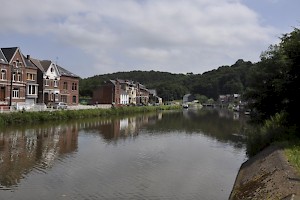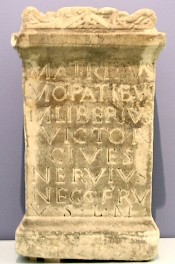Sambra (Sambre)
Q208267Sambra: river in Gallia Belgica, modern Sambre.

The river Sambre has its sources near modern Nouvion-en-Thiéreache in northern France, and flows in a northeastern direction, until it empties itself in the river Meuse (ancient Mosa) at Namur (ancient Namurcum). The heavily canalized stream is now about 172 km long, divided almost equally over France (85 km) and Belgium (87 km). In Antiquity, the easternmost part of the river was part of the country of the Atuatuci; the westernmost part belonged to the Atrebates, while it the central part of the river was in the country of the Nervians. All these tribes were defeated by Julius Caesar in the summer of 57 BCE.
During the Roman age, the river was of great strategic importance, because many Nervian farmers produced wheat and barley, which was shipped to Cuijk and Maastricht, from where it was transported by land to the legionary bases along the river Rhine. (An interesting inscription illustrating this trade was found in Nijmegen, and mentions a Nervian named Marcus Liberius Victor.)

Without the rivers Sambre and Meuse, it would have been almost impossible to feed the army of Germania Inferior. The river was still important in the Frankish period; it is mentioned in several Merovingian hagiographies.note
For unknown reasons, the river Sabis mentioned by Caesarnote as the site of his victory over the Nervians, has in the eighteenth century been identified with the Sambra of the other Latin sources, although it is difficult to explain how Caesar's men can have ignored the clear /mbr/ and changed it into a simple /b/, adding an /s/. That Caesar overcame his opponents at the Selle, already suggested in 1898, was proved conclusively more than half a century ago.
Literature
- Pierre Turquin, "La Bataille de la Selle (du Sabis) en l' An 57 avant J.-C." in Les Études Classiques 23/2 (1955), 113-156